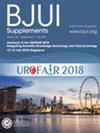The association of smoking with urinary and sexual function recovery following radical prostatectomy.
IF 3.7
2区 医学
Q1 UROLOGY & NEPHROLOGY
引用次数: 0
Abstract
OBJECTIVE To investigate the association of smoking with post-prostatectomy functional recovery in a large population-based cohort using standardised outcome measures. PATIENTS AND METHODS We conducted a cohort study and reported findings according to the STROBE (Strengthening the Reporting of Observational Studies in Epidemiology) guidelines. We used a registry with prospectively gathered patient-reported outcome measures (PROMs) regarding health and morbidity. We included all men who underwent radical prostatectomy (RP) for localised prostate cancer, without (neo)adjuvant hormone or radiotherapy treatment. In our analysis, we compared Expanded Prostate Cancer Index Composite-26 (EPIC-26) scores between people who had ever smoked and those who had not during 24 months' follow-up. We identified significant confounders by means of a causal directed acyclic graph, adjusted for these, and performed subgroup and sensitivity analyses. RESULTS In total, 2676 patients were included in the analysis. PROM data were available for 61% of the total 4356 otherwise eligible participants. Multivariable regression analysis showed that patients who had ever smoked (ever smokers) scored 11 points lower for sexual function (95% confidence interval -15.0, -7.0) compared to never smokers during 24 months' follow-up. Subgroup analysis showed that individuals with baseline scores above 80 were more at risk of sexual function loss. Urinary incontinence scores were similar between ever smokers and never smokers. CONCLUSION Smoking was associated with lower sexual function scores in the first 2 years after RP, but not with changes in urinary incontinence outcomes.吸烟与根治性前列腺切除术后泌尿和性功能恢复的关系。
目的:在一项以人群为基础的队列研究中,采用标准化的结果测量方法,研究吸烟与前列腺切除术后功能恢复的关系。患者和方法我们进行了一项队列研究,并根据STROBE(加强流行病学观察性研究报告)指南报告了研究结果。我们使用前瞻性收集患者报告的关于健康和发病率的结果测量(PROMs)的注册表。我们纳入了所有接受根治性前列腺切除术(RP)治疗局限性前列腺癌的男性,没有(新)辅助激素或放疗治疗。在我们的分析中,我们在24个月的随访中比较了曾经吸烟的人和没有吸烟的人的扩展前列腺癌指数综合-26 (EPIC-26)评分。我们通过因果有向无环图确定了重要的混杂因素,对这些因素进行了调整,并进行了亚组和敏感性分析。结果共纳入2676例患者。4356名符合条件的参与者中有61%的PROM数据可用。多变量回归分析显示,在24个月的随访中,曾经吸烟(曾经吸烟)的患者在性功能方面的得分比从未吸烟的患者低11分(95%可信区间为-15.0,-7.0)。亚组分析显示,基线得分在80分以上的个体性功能丧失的风险更大。曾经吸烟者和从不吸烟者的尿失禁评分相似。结论吸烟与RP术后2年内较低的性功能评分有关,但与尿失禁结局无关。
本文章由计算机程序翻译,如有差异,请以英文原文为准。
求助全文
约1分钟内获得全文
求助全文
来源期刊

BJU International
医学-泌尿学与肾脏学
CiteScore
9.10
自引率
4.40%
发文量
262
审稿时长
1 months
期刊介绍:
BJUI is one of the most highly respected medical journals in the world, with a truly international range of published papers and appeal. Every issue gives invaluable practical information in the form of original articles, reviews, comments, surgical education articles, and translational science articles in the field of urology. BJUI employs topical sections, and is in full colour, making it easier to browse or search for something specific.
 求助内容:
求助内容: 应助结果提醒方式:
应助结果提醒方式:


